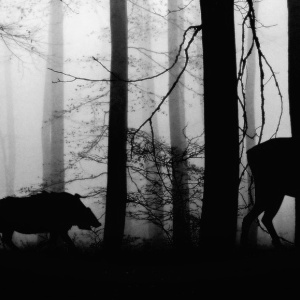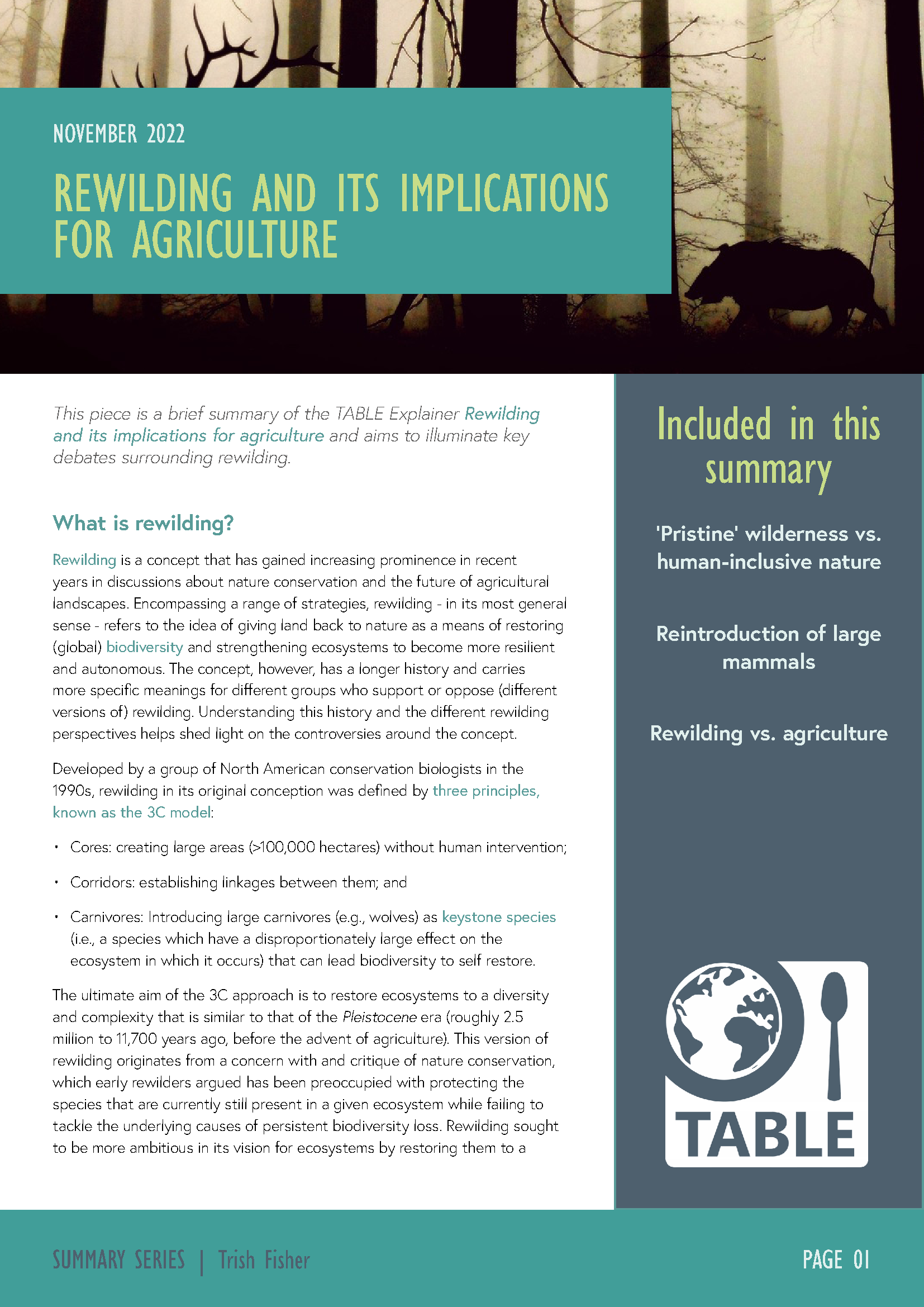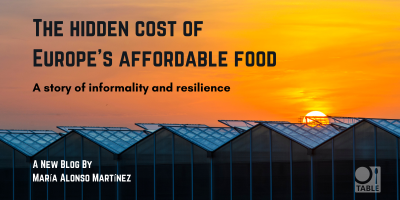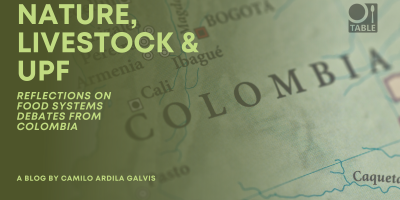
This is a brief summary of the longer TABLE Explainer “Rewilding and its implications for agriculture”.
It aims to illuminate key debates surrounding rewilding.
Written by Trish Fisher
Rewilding and its implications for agriculture: Summary
What is rewilding?
Rewilding is a concept that has gained increasing prominence in recent years in discussions about nature conservation and the future of agricultural landscapes. Encompassing a range of strategies, rewilding - in its most general sense - refers to the idea of giving land back to nature as a means of restoring (global) biodiversity and strengthening ecosystems to become more resilient and autonomous. The concept, however, has a longer history and carries more specific meanings for different groups who support or oppose (different versions of) rewilding. Understanding this history and the different rewilding perspectives helps shed light on the controversies around the concept.
The origins of the term
Developed by a group of North American conservation biologists in the 1990s, rewilding in its original conception was defined by three principles, known as the 3C model:
- Cores: creating large areas (>100,000 hectares) without human intervention;
- Corridors: establishing linkages between them; and
- Carnivores: Introducing large carnivores (e.g., wolves) as keystone species (i.e., a species which have a disproportionately large effect on the ecosystem in which it occurs) that can lead biodiversity to self restore.
The ultimate aim of the 3C approach is to restore ecosystems to a diversity and complexity that is similar to that of the Pleistocene era (roughly 2.5 million to 11,700 years ago, before the advent of agriculture). This version of rewilding originates from a concern with and critique of nature conservation, which early rewilders argued has been preoccupied with protecting the species that are currently still present in a given ecosystem while failing to tackle the underlying causes of persistent biodiversity loss. Rewilding sought to be more ambitious in its vision for ecosystems by restoring them to a distant past. Underpinning the 3C approach is the idea that the reintroduction of (relatives of) extinct carnivore species, combined with the protection of large swathes of land from human interference, will enable ecosystems to become more complex and biodiverse.
Today, rewilding is a heterogeneous and evolving movement which includes an increasingly diverse range of context-specific strategies beyond the original 3C model. Generally, two primary, yet somewhat overlapping, schools of thought have emerged about how to implement rewilding efforts: trophic rewilding and passive rewilding. Trophic rewilding focuses on restoring the complex web of predator-prey interactions in an ecosystem, building on the original 3C approach but without explicitly naming a specific historical baseline or ideal scale rewilding should be applied at. It generally revolves around the intentional reintroduction of large herbivore or carnivore species by humans. In contrast, passive rewilding denotes the spontaneous rewilding of ecosystems when land is left to its own devices. Passive rewilding involves little or no human intervention and does not specify an ideal historical baseline or seek to actively reintroduce keystone species.
To date, most rewilding projects have, by and large, followed the trophic rewilding approach. Relatively few in number and implemented at a fairly small scale, rewilding projects are currently primarily found in North America and Europe, but also more recently spread to other parts of the world including South Africa and China. Besides these rewilding projects, there are also significant amounts of land globally - likely much more than currently covered by rewilding projects - that are rewilding passively simply because agricultural land has been abandoned.
Debates regarding rewilding
In recent years, rewilding as an idea and in its appeal has grown beyond the academic field of conservation biology and gained wider traction among a diverse group of stakeholders including environmentalists, philanthropists, journalists, corporations, farmers, and policymakers. In practice, most rewilding efforts share a focus on restoring the functional complexity of ecosystems. Given its implications for land use, agriculture, and humans’ relationship with nature, rewilding is a subject of significant contestation. Debates about rewilding have evolved from a focus on the reintroduction of (locally) extinct species and their relatives, to a wider discussion about the future of nature, agriculture, and rural landscapes in the Anthropocene.
‘Pristine’ wilderness vs. human-inclusive nature
One of the most central debates about rewilding concerns the relationship between humans and nature and the question of whether ‘pristine’ wilderness, free of human intrusion, should be the ideal for conservation efforts. The original proponents of rewilding believe that humanity has marginalised nature by giving it ever less space, at devastating cost to biodiversity. Their 3C approach builds on and revamps a tradition in the North American conservation movement that is preoccupied with the protection of ‘wilderness’ and which can be found in the work of John Muir and others who contributed to the development of the first national parks in the US. This conception of wilderness has critics both within and outside the rewilding movement. Much of the criticism about the explicit focus on human-free wilderness draws from a socio-historical lens that positions rewilding within a much longer tradition of eco-imperialist and colonialist conservation activities that have often gone hand in hand with the eviction, denigration, and displacement of rural and Indigenous communities. Furthermore, the idea of ‘pristine’ wilderness ignores the role of Indigenous peoples and other rural communities in managing supposedly ‘wild’ landscapes for centuries or millennia. This critique sees rewilding as legitimising existing inequalities and undermining conservation agendas that support both social and ecological justice.
As the rewilding movement has grown, many newer adherents have abandoned the idea of historical baselines and seek to create new ways for humans and wildlife to live together in the Anthropocene. These proponents of rewilding advocate for a more future-oriented approach that embraces a human-inclusive ethos which seeks ‘win- wins’ for both humans and nature; many argue for a mixed approach of both isolated places and human-inclusive sites. This branch of the rewilding movement places more emphasis on ‘wildness’ (a quality of being) rather than ‘wilderness,’ and emphasises the potential for human land use and nature to be synergistic. However, critics of rewilding note that not all of these more future-oriented approaches are truly more human-inclusive, despite their rhetoric.
Reintroduction of large mammals
Key to the original concept of rewilding is the idea that keystone species that have since gone extinct (or their functional analogues) must be reintroduced to restore ecosystems. Two primary approaches to reintroducing (locally) extinct species have been pursued by rewilding projects: back breeding and genetic engineering. Back breeding entails the deliberate, selective breeding of animals in an attempt to restore traits they are thought to share with extinct species. For example, Heck cattle are commonly used in European conservation projects as they are thought to be similar to extinct aurochs which once lived in Eurasia. Genetic engineering is a highly controversial strategy in which the genome of a living species is edited to more closely resemble that of an extinct relative species. Current genetic engineering methods cannot create an exact copy of an extinct species (although this may be possible in the future), but rather an animal with similar traits.
Critics of large mammal reintroductions believe that their proponents rely on oversimplified understandings of how reintroduced species will interact with their environment and nearby human population centres. In particular, critics point to the risk of human-wildlife conflicts (particularly in regards to the potential reintroduction of large carnivores) and the potential for reintroduced species to have comparable impacts to so-called ‘invasive’ species, namely devastating existing populations of ‘native’ species. (The native/invasive species dichotomy and invasive species’ purported negative impacts on ecosystems are also contested ideas in parts of the rewilding movement.)
Rewilding vs. agriculture
The future of agriculture and farming communities constitutes a major area of discussion in the rewilding debate. If rewilding were to significantly scale-up, much of the land dedicated to rewilding efforts would realistically require agricultural land to be taken out of production or, at the very least, used in very different ways. As such, many agricultural communities are opposed to rewilding given the necessity of agricultural land use change to achieve rewilding goals.
Among proponents of rewilding, there is disagreement regarding the most effective approach to balancing conservation goals with agricultural production. On
one extreme end of the rewilding debate, rewilding proponents aim to free up the maximum amount of land for nature by intensifying agricultural production (i.e., land sparing). This perspective is exemplified by the controversial ‘Nature Needs Half’ campaign which aims to protect half of earth for conservation by 2030 (although the campaign also emphasises the role of nature conservation in protecting traditional livelihoods such as smallholder agriculture). Other rewilding proponents take a more conciliatory approach and seek to foster rewilding goals wherever possible, while balancing other socioeconomic priorities including agricultural production.
This approach is more aligned with the regenerative agriculture and agroecology movements which are, broadly speaking, more closely associated with a land sharing model that integrates both agricultural production and nature conservation on the same land. Despite these different approaches to agricultural production within the rewilding movement, there are also areas of broad alignment. Many in the rewilding movement agree that wider, socioeconomic changes are necessary to alter our relationship with nature and create conditions under which nature could flourish (e.g., reducing the global consumption of land-intensive foods such as meat and dairy).
Conclusion
Rewilding is a concept that was born out of the field of conservation biology but has taken on wider meaning in discussions regarding the future of nature, agriculture, and rural landscapes in the Anthropocene. Debates about rewilding centre on whether conservation should embrace ‘pristine’ or human-inclusive visions for nature, the risks and benefits of reintroducing large mammals, and whether and when agricultural production can be compatible with biodiversity conservation. In the face of anthropogenic climate change and the biodiversity crisis, debates about rewilding are entangled with questions regarding the future of land use and agricultural production and the rights of rural and Indigenous peoples in shaping the future of rural landscapes.









Post a new comment »